Summary Statement
Description of a respiratory protection program, including when a respirator is needed, medical evaluations, types of respirators and how to select the proper one.
Winter 2004
| Presented at the 14th Annual Construction Safety Conference & Exposition, Rosemont, IL, February 2004. |
Respiratory illnesses in construction are unforgiving; they can make the strongest, hard working tradesman weak, exhausted and unable to work.
These illnesses are attributed to the chemicals we work with to the very building materials we mold into structures and roads. As a contractor, knowing the basics of an effective respiratory protection program will allow a better understanding of the seriousness of the hazard.
Important: Respirators should be used for protection only when engineering controls have been shown to be infeasible for the control of the hazard or during the interim period when engineering controls are being installed.
An effective respiratory protection program needs to be able to perform the following key functions:
- Determine whether respirators are required due to hazards in the work environment;
- Identify which respirator will be needed to provide the best protection;
- Ensure that all employees required to do so are medically able to wear a respirator and perform their work;
- Ensure that the selected respirator properly fits each employee required to wear one;
- Ensure that each employee is trained on the respirator’s use, limitations, storage, maintenance, cleaning and disinfecting; and,
- Ensure that each of the above is properly documented and reviewed for its effectiveness as part of a site-specific written respiratory protection program.
(a) Need for Respiratory Protection
Respirators are required to be worn by workers whenever the following three conditions arise:
- Exposures exceed the OSHA Permissible Exposure Limit for a chemical or substance;
- Engineering controls are being put in place, but have not yet reduced exposures below the OSHA Permissible Exposure Limit; or,
- The employer/Incident Commander requires respirators to be worn.
If those three conditions do not exist, then the use of respirators is not required.
If an employer allows voluntary use of respirators, then, they must do the following:
- For disposable filtering face piece respirators; the employer provides a copy of Appendix D of the respirator standard (29 CFR 1910.134).
- For cartridge/filter elastomeric (rubber) face piece respirators; the employer provides medical clearance, cleaning and disinfecting training and a copy of Appendix D of the respirator standard (29 CFR 1910.134).
 |
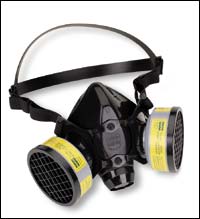 |
North 7140 N-95 Filtering Face Piece Respirator |
North 7700 Series Half Mask Air-Purifying Respirator |
Appendix D to Sec. 1910.134 (Mandatory) Information for Employees Using Respirators When Not Required Under the Standard
Respirators are an effective method of protection against designated hazards when properly selected and worn. Respirator use is encouraged, even when exposures are below the exposure limit, to provide an additional level of comfort and protection for workers. However, if a respirator is used improperly or not kept clean, the respirator itself can become a hazard to the worker. Sometimes, workers may wear respirators to avoid exposures to hazards, even if the amount of hazardous substance does not exceed the limits set by OSHA standards. If your employer provides respirators for your voluntary use, or if you provide your own respirator, you need to take certain precautions to be sure that the respirator itself does not present a hazard.
When using a respirator, do the following:
- Read and heed all instructions provided by the manufacturer on use, maintenance, cleaning and care, and warnings regarding the respirators limitations.
- Choose respirators certified for use to protect against the contaminant of concern. NIOSH, the National Institute for Occupational Safety and Health of the U.S. Department of Health and Human Services, certifies respirators. A label or statement of certification should appear on the respirator or respirator packaging. It will tell you what the respirator is designed for and how much it will protect you.
- Do not wear your respirator into atmospheres containing contaminants for which your respirator is not designed to protect against. For example, a respirator designed to filter dust particles will not protect you against gases, vapors, or very small solid particles of fumes or smoke.
- Keep track of your respirator so that you do not mistakenly use someone else's respirator.
(b) Respirator Selection
The type of respirator to use in any situation is determined by the Program Administrator. OSHA requires that an employer designate a Program Administrator to oversee employee respiratory protection and ensure compliance to the OSHA Regulations.
Cartridge-type respirators or air supplying respirators can only reduce exposures to hazardous gases or vapors. Filtering facepiece respirators, filtered elastomeric facepiece respirators, or air supplying respirators can reduce exposures to hazardous dusts, fumes, mists and other particles.
Each type of mask gives a different level of protection, measured by the amount of air leaking into the mask where it comes in contact with the face.
A respirator can only reduce exposure never eliminate it.
The Program Administrator must take into account the type of exposure, the level of exposure (amount) and other work and environmental factors to choose the most appropriate respirator to protect workers. Some features of the different types of respirators are as follows:
Filtering Face Piece, Half-Face, Disposable, Negative Pressure, Air-Purifying Respirator
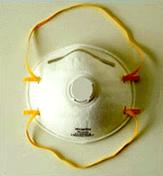
North 7140 N-95 Filtering Face Piece Respirator
Advantages: Disposable, easy to breathe through, easier to use under welding hoods/helmets and with face shields.
Disadvantages: Least protection (although rated the same as elastomeric half-face), still has to be fit tested if used to reduce exposures above PEL, not allowed for use in atmospheres with less than 19.5% Oxygen.
Elastomeric Half-Face, Cartridge/Filter, Negative Pressure, Air-Purifying Respirator
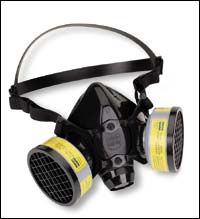
North 7700 Series Half Mask Air-Purifying Respirator
Advantages: Can be used with a variety of cartridges/filters to protect in different exposure environments, provides a reduction of exposure by a factor of 10 (10% leakage)
Disadvantages: Still hard to get a good fit with some people, requires regular cleaning and periodic disinfecting, requires maintenance and replacement of parts, not allowed for use in atmospheres with less than 19.5% Oxygen, may be difficult to use with other PPE (safety glasses, under welding hoods/helmets, with face shields).
Elastomeric Full-Face, Cartridge/Filter, Negative Pressure, Air-Purifying Respirator

North 7600 Series Full Facepiece Air-Purifying Respirator
Advantages: Can be used with a variety of cartridges/filters to protect in different exposure environments, provides a reduction of exposure by a factor of 50 (2 % leakage), built in safety eye protection (face piece meets or exceeds ANSI Z87.1 – Occupational Eye & Face Protection), easier to fit, some models equipped with heat resistant face shield and welding lens holder for welding without a hood.
Disadvantages: Requires regular cleaning and periodic disinfecting, requires maintenance and replacement of parts, not allowed for use in atmospheres with less than 19.5% Oxygen, may be difficult to use with prescription eyewear, no glasses with side bars, contact lenses allowed).
Powered Air-Purifying Respirator (PAPR)
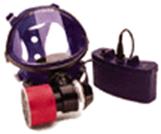
Advantages: Provides a reduction of exposure by a factor of 50 (2 % leakage), built in safety eye protection (face piece meets or exceeds ANSI Z87.1), easier to fit, easier on heart and lungs.
Disadvantages: Requires regular cleaning and periodic disinfecting; requires maintenance and replacement of parts; not allowed for use in atmospheres with less than 19.5% Oxygen; may be difficult to use with prescription eyewear (no glasses with side bars, contact lenses allowed); when battery fails, becomes equivalent to full-face, negative pressure.
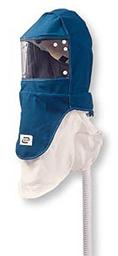
Advantages: Provides a reduction of exposure by a factor of 25 (4 % leakage) for hooded and helmeted, by a factor of 1,000 (0.1% leakage) for hoods with tight fitting face piece underneath, some have built in safety eye protection (face piece meets or exceeds ANSI Z87.1), easier to fit, easier on heart and lungs, requires Compressed Gas Association (CGA) Grade D breathing air, can be used in Oxygen deficient atmospheres with appropriate escape measures provided (belt mounted escape air bottle).
Disadvantages: Requires regular cleaning and periodic disinfecting; requires maintenance and replacement of parts; requires compressed air tanks or compressor, with compressor having alarm for temperature/Carbon Monoxide; periodic testing to ensure Grade D air from compressor.
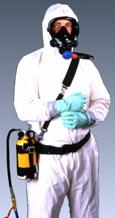
Advantages: Provides a reduction of exposure by a factor 2,000 (0.05% leakage), built in safety eye protection (face piece meets or exceeds ANSI Z87.1), easier to fit, easier on heart and lungs, requires Compressed Gas Association (CGA) Grade D breathing air, can be used in Oxygen deficient atmospheres with appropriate escape measures provided (belt mounted escape air bottle).
Disadvantages: Requires regular cleaning and periodic disinfecting; requires maintenance and replacement of parts; requires compressed air tanks or compressor, with compressor having alarm for temperature/Carbon Monoxide; periodic testing to ensure Grade D air from compressor.
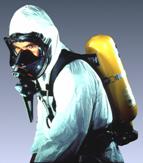
Advantages: Provides a reduction of exposure by a factor 10,000 (0.01% leakage), built in safety eye protection (face piece meets or exceeds ANSI Z87.1), easier to fit, requires Compressed Gas Association (CGA) Grade D breathing air, can be used in Oxygen deficient atmospheres with appropriate escape measures provided (belt mounted escape air bottle).
Disadvantages: Requires regular cleaning and periodic disinfecting; requires maintenance and replacement of parts; requires compressed air tanks having alarm for time left in bottle; weight requires fit wearer; limited time of use; tanks checked for leakage/integrity; periodic testing to ensure Grade D air from compressor.
Respirator Cartridge/filter Color-Codes |
|
| Organic Vapor | Black |
| Acid Gas | White |
| Organic Vapor/Acid Gas | Yellow |
| Amonia | Green |
| P-100 (HEPA) | Magenta |
| Multi-Gas/Vapor | Olive |
(c) Medical Evaluation
After determining which respirator is required, the Program Administrator needs to make sure that the employees are physically able to wear the respirators required. The medical evaluation is performed in one of two manners. First, a confidential questionnaire (Appendix C of the Respirator Standard, 29 CFR 1910.134) can be given during work hours or at a time and location convenient for the workers. It must be given in a language that the employee can read. OSHA has translated the questionnaire into Spanish. If the employee cannot read, they may bring someone from home to read the questions to the employee. The employer may not provide this person, or be present during the questioning. After completing the questionnaire, the employee puts it into an envelope and seals it. The employer can then send the sealed questionnaire to their designated Physician or Licensed Health Care Professional (PLHCP).
Another method of medical evaluation is to send the employee to the PLHCP for a face-to-face evaluation where the PLHCP asks the same questions as those found on the questionnaire. The employer must provide a copy of their written respirator program to the PLHCP as well as the medical evaluation section of the Respirator Standard.
After evaluating the employees, the PLHCP sends a letter back to the employer stating four things:
- The employee can or cannot wear the respirator;
- Any limitations on respirator use for that employee;
- The need and frequency for follow-up evaluations; and,
- That the PLHCP has communicated this information to the employee.
This is the Medical Record, which must be kept for the employee’s duration of employment plus thirty (30) years thereafter. At no time does the employer ever see the questionnaire.
Note: 29 CFR 1926.33 contains the standard for medical records and their retention.
(d) Fit Testing
The next step is to fit test the employee with the selected respirator. There are four methods of fit testing qualitatively (pass/fail) and three methods quantitatively (measures actual fit). These are detailed in Appendix A of the Respiratory Protection Standard, 29 CFR 1910.134. OSHA allows qualitative testing for all respirators except full-face, negative pressure, air-purifying respirators.
 North 7600 Series Full Facepiece Air-Purifying Respirator These are required to be quantitatively fitted. |
Prior to the fit test, a fit check is performed to make sure a good seal is obtained. In addition, the employee should wear the mask for five minutes prior to fitting to ensure comfort. Fit checks are done both negatively and positively.
To perform a negative pressure fit check; cover the inlets to the filters or cartridges, and inhale to cause the face piece to pull against the face. The employee then holds their breath. If the face piece relaxes, there is a substantial leak and either another mask is selected or the mask is adjusted.

Negative Pressure Fit Check
To perform a positive pressure fit check; cover or block the exhalation valve and blow out steadily, as if blowing out a candle. The face piece should expand, but no air should be felt leaking out.
After passing the fit check, the fit test can be performed.
The qualitative fit test is done using a taste test (saccharin or Bitrex ? ), an odor test (banana oil/iso amyl acetate), or a reaction test to irritant smoke.

Positive Pressure Fit Check
The quantitative tests use machines to measure the actual leakage through the face seal of particles or the change in pressure due to air leakage. The three tests are corn oil mist particle counting, condensation nuclei counter (CNC) or PortaCount, and the Dynatech FitTester 3000, which measures pressure difference. They all need adapters to allow sampling inside the mask.

Dynatech Fit Tester 3000
Employees must be re-fitted at least annually. Additional fit testing may be required if the employee:
- Has substantial weight gain or loss (> 10% of their body weight);
- Has cosmetic surgery;
- Has had extensive dental work; or,
- If the employee reports that the respirator is not passing a fit check.
(e) Training
In addition to the fit testing, employees require training on how to use, maintain, store, clean and disinfect their respirators (procedures for cleaning and disinfecting are found in Appendix B of the Respiratory Protection Standard, 29 CFR 1910.134). The wearer must be trained on the respirator’s limitations. This training must be performed prior to using the respirator in a work or rescue environment and must include annual refresher training and re-training when an employee demonstrates misuse. The training, as with the medical questionnaire, must be in a language that the employee understands.
(f) Written Program
Finally, after selection, medical clearance, fit testing and training, an employee is able to wear a respirator in the work area. The Program Administrator is required to have at the job site a written program that details specifically each aspect of respirator use at that site. This written program must be made available to employees or their representatives and OSHA compliance officers during inspections.


